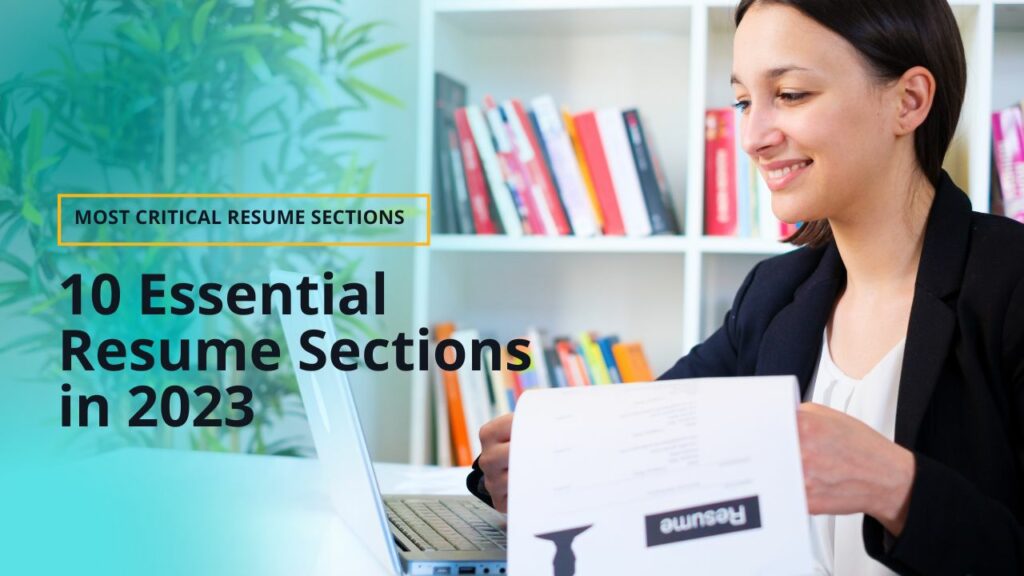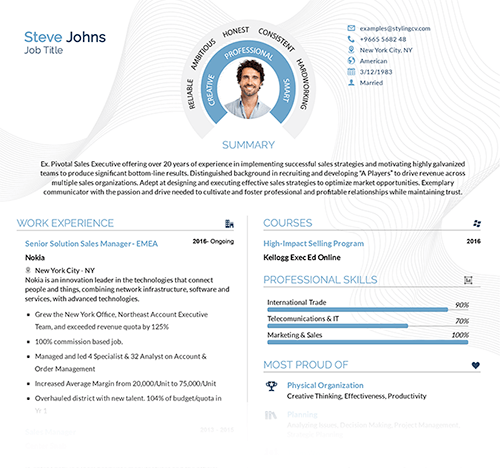
secções de um currículo Existem 5 secções principais de um currículo que deve sempre incluir: um cabeçalho, um resumo ou objetivo do currículo, a sua experiência profissional, a sua informação sobre a sua escolaridade e uma secção de competências...
Ajuda com o currículo - 10 secções essenciais do currículo em 2023
Obtenha já o seu currículo gratuito10 secções essenciais dos currículos em 2023
Existem 5 secções principais do currículo que deve sempre incluir: um cabeçalho, um resumo ou objectivo do currículo, a sua experiência profissional, a informação sobre a sua escolaridade e uma secção de competências. Além disso, existem algumas áreas alternativas que pode incluir se houver espaço disponível. Sabia que apenas cerca de 25% dos currículos...
manjericão
Especialista em Conteúdos


Existem 5 secções principais do currículo que deve sempre incluir: um cabeçalho, um resumo ou objetivo do currículo, a sua experiência profissional, a informação sobre a sua escolaridade e uma secção de competências. Além disso, existem algumas áreas alternativas que pode incluir se houver espaço disponível.
Sabia que apenas cerca de 25% dos currículos enviados passam efetivamente pelos sistemas de acompanhamento de candidatos e chegam aos computadores dos recrutadores? Pode pensar que enumerou as suas melhores qualidades e que tem boas hipóteses de ser contratado, mas o seu currículo pode nem sequer chegar aos recrutadores se não incluir os elementos que eles procuram. Isto significa que se está ativamente à procura de emprego e a enviar os seus currículos para diferentes organizações, tem de garantir que está a adotar as melhores práticas que farão com que o seu currículo se destaque.
Afinal de contas, é uma indústria competitiva e apenas os melhores dos melhores chegam aos processos finais de contratação. Com um currículo bem escrito e bem estruturado, pode garantir que passa à fase seguinte e que o seu currículo não vai parar a uma pasta de lixo algures.
O truque para um currículo bem concebido é concentrar-se nas 10 secções principais do currículo. Neste artigo, discutiremos como escrever cada secção do currículo, que detalhes deve incluir ou omitir e a importância de cada passo. Também discutiremos como a formatação e a estruturação do seu currículo podem aumentar as suas hipóteses de ser notado.
Vamos começar.
Principais secções do currículo em que se deve concentrar
Pense no seu currículo como um menu. Sabe como cada secção do menu apresenta uma categoria de comida diferente e facilita a finalização do seu pedido? É mais ou menos assim que funciona um currículo. Só que, em vez de categorias de alimentos, destaca as suas qualificações e experiências.
Cada secção do currículo representa um aspeto único de si. Desde detalhes pessoais e objectivos a conjuntos de competências e experiências, as secções do currículo ajudam-no a organizar a sua informação de forma ordenada.
Aqui estão alguns dos componentes mais importantes de um currículo que não pode descurar:
1. Secção de contactos
A secção de contactos é a primeira coisa que os recrutadores devem ver quando abrem o seu currículo. Isto significa que tem de estar no topo do seu currículo.
Deve estar a perguntar-se porque é que a secção de contactos tem de ser colocada logo no início. Afinal de contas, não são as suas competências e experiência as verdadeiras estrelas do seu currículo? Não é por isso que deve destacá-las em primeiro lugar?
Bem, embora estes sejam detalhes importantes que afectam diretamente o processo de decisão, são as informações de contacto que os recrutadores utilizam para entrar em contacto com os candidatos. Se estas informações não constarem do seu currículo ou forem difíceis de encontrar, é provável que não receba a chamada ou o e-mail de que estava à espera!

O que deve incluir:
Certifique-se de que verifica novamente o seu currículo quanto aos seguintes pormenores:
- Nome e apelido
- Endereço de correio electrónico
- Número de telefone
- Perfil LinkedIn (opcional)
- Localização (cidade e estado)
Não tem de incluir o seu endereço de casa no seu currículo. Também pode optar por incluir ou omitir links para as suas contas de redes sociais ou outros canais, dependendo da função a que se está a candidatar. Por exemplo, se estiver a candidatar-se a uma posição de marketing digital e tiver o seu blogue ou website, recomenda-se que o inclua na secção de contactos, uma vez que reflectirá as suas competências.
Todas as informações que incluir na secção de contactos devem ser profissionais. Se ainda não tiver um endereço de correio eletrónico profissional, crie um novo utilizando o formato firstname.lastname@gmail.com.
2. Objetivo ou resumo do currículo
A secção seguinte do currículo é o objetivo ou o resumo do currículo. Estes são utilizados para descrever brevemente os seus objectivos profissionais. Note que um objetivo de currículo não é a mesma coisa que um resumo de currículo.
O objetivo de um currículo é uma introdução de 2-3 linhas sobre as suas competências profissionais e objectivos de carreira e destina-se a explicar por que razão é um bom candidato para a função. Um resumo do currículo é uma descrição igualmente concisa da sua experiência profissional e tem como objetivo destacar as suas maiores realizações e competências profissionais.
O que deve incluir:
- Um objetivo de currículo é mais adequado para pessoas que pretendem mudar de carreira. Também é útil para recém-licenciados ou pessoas com pouca experiência profissional.
- Recomenda-se um resumo do currículo para pessoas com experiência profissional significativa e que se candidatam a lugares de topo.
Escolha a que melhor se adapta às suas necessidades de emprego.
3. Experiência profissional
Em seguida, o seu currículo precisa de uma secção que destaque a sua experiência profissional. Esta é, sem dúvida, uma das componentes mais importantes do seu currículo e é cuidadosamente avaliada pelos recrutadores. Descreve as suas experiências profissionais passadas e actuais e serve como um registo do seu histórico de emprego. Não precisa de incluir todos os empregos que teve nesta secção. Tente mantê-la o mais relevante possível, mencionando as experiências mais relacionadas com a função a que se está a candidatar.
Claro que isto depende dos seus anos de experiência. Por exemplo, se é recém-licenciado ou trabalha há apenas alguns anos, pode querer incluir as suas experiências de estágio e mencionar os empregos em part-time que teve durante a faculdade. Por outro lado, se tem mais de 10 anos de experiência, deve incluir apenas os empregos e cargos mais importantes.
O que deve incluir:
Para cada cargo mencionado, deve mencionar claramente o seguinte:
- Título/designação do cargo
- Nome da empresa
- Localização
- Datas de emprego
- Breve descrição das responsabilidades e tarefas
- Principais realizações
Certifique-se de que está a utilizar o pretérito perfeito quando escrever as descrições de funções de empregos anteriores. Utilize o presente do indicativo para a experiência profissional atual mencionada.
4. Habilitações académicas
A quarta secção do currículo a que deve prestar atenção é a secção de educação. Esta secção dá aos recrutadores uma visão da sua formação académica e destaca quaisquer prémios ou realizações que possa ter recebido durante os seus anos de faculdade ou escola.

O que deve incluir:
Mais uma vez, as qualificações académicas que deve enumerar dependem da sua experiência e do cargo a que se candidata. Um recém-licenciado pode mencionar os seus diplomas e realizações do ensino secundário. Um profissional mais experiente pode apenas incluir os detalhes da sua formação superior. Em qualquer dos casos, deve mencionar:
- Título do grau/diploma
- Nome do programa
- Nome do estabelecimento de ensino
- Major (facultativo)
- Prémios recebidos (facultativo)
- GPA (facultativo)
5. Competências
A secção de competências do seu currículo é a sua oportunidade para enumerar todas as competências relevantes e específicas que possui. Esta secção do currículo dá aos recrutadores uma visão rápida das suas capacidades e ajuda-os a identificar se possui as competências necessárias para o emprego. Enumere as suas competências em colunas com marcadores para facilitar a leitura.
O que deve incluir:
A escolha das competências depende do sector a que se candidata. Deve incluir:
- Competências técnicas relevantes para a função
- Competências universais que podem ser utilizadas no emprego (por exemplo, competências informáticas, competências em marketing digital, competências em Photoshop, etc.)
- Competências transversais que melhor se adequam à função (por exemplo, competências de pensamento crítico, competências de liderança, competências de comunicação, etc.)
Utilize as palavras-chave certas para otimizar a sua secção de competências e dar a conhecer aos potenciais empregadores as suas áreas de especialização.
Secções opcionais do currículo que pode incluir
Para além dos elementos obrigatórios acima referidos, pode também incluir informações adicionais no seu currículo. No entanto, certifique-se de que não está a adicionar estes detalhes apenas por adicionar. Se as informações adicionais forem irrelevantes ou não acrescentarem valor ao seu currículo, é melhor excluí-las.
Eis as secções opcionais do currículo em que pode concentrar-se:
6. Prémios e realizações
Não faz mal nenhum flexibilizar um pouco os seus feitos! Se recebeu prémios, elogios ou certificações que não pôde incluir nas secções de trabalho e formação, esta é a sua oportunidade de os realçar. Pode incluir:
- Publicações
- Honras
- Reconhecimento internacional
- Certificações em linha/fora de linha
- Prémios e medalhas
Não se esqueça de mencionar o nome de cada prémio, bem como a data em que o recebeu. Pode também incluir uma breve descrição do prémio.

7. Línguas
Ficaria surpreendido se soubesse o quanto os recrutadores valorizam os candidatos que dominam várias línguas. Esta é uma competência especialmente cobiçada se a função exigir uma rede global de contactos ou se a descrição da função mencionar especificamente as preferências linguísticas.
Se falar fluentemente mais do que uma língua, inclua uma secção de línguas. Refira também o seu nível de fluência (por exemplo, principiante, intermédio ou avançado) ao lado da língua.
8. Trabalho voluntário
Os recrutadores adoram candidatos que tenham participado em alguma forma de serviço comunitário ou trabalho voluntário. Que melhor forma de mostrar a sua paixão por retribuir à comunidade do que listar as suas experiências de voluntariado no seu currículo? Isto é especialmente útil se o trabalho comunitário em questão corresponder às metas e objectivos da empresa ou se se relacionar bem com a função a que se está a candidatar. Também pode contar como experiência profissional se for um recém-licenciado com pouca experiência profissional.
Ao enumerar as suas experiências, não se esqueça de incluir a:
- Nome da organização ou instituição de solidariedade social com que trabalhou
- Duração do trabalho
- Localização
- Tarefas e actividades relevantes em que participou
- Principais realizações
9. Passatempos
Surpreendido por ver isto? Permita-nos explicar-lhe.
Esta secção do currículo é uma forma de mostrar os seus interesses e actividades aos recrutadores, dando-lhes um vislumbre da sua personalidade. As coisas de que gosta dizem muito sobre si, e incluir passatempos relevantes e interessantes pode causar uma boa impressão nos recrutadores que analisam o seu currículo.
Naturalmente, isto não significa que deve enumerar todos os passatempos. Seja breve e interessante e tente incluir passatempos que correspondam às suas competências técnicas ou pessoais. Para os recém-licenciados, esta é uma forma criativa de preencher o espaço em branco no seu currículo. Além disso, um passatempo interessante pode tornar-se um tópico de discussão durante uma entrevista!

10. Actividades e projectos extracurriculares
Esta secção do currículo é mais relevante para recém-licenciados ou jovens empregados com experiência limitada. Destaca as suas actividades extracurriculares e projectos não relacionados com o trabalho, mostrando aos recrutadores que fez mais do que apenas estudar na universidade. Também mostra que gosta de se manter empenhado e de encontrar novas formas de conseguir um equilíbrio entre a vida profissional e pessoal.
Pode utilizar esta secção do currículo para mencionar:
- Clubes ou sociedades a que pertence ou pertenceu
- Conferências, workshops ou seminários em que tenha participado
- Actividades paralelas (por exemplo, freelancer, actividades em casa, etc.)
- Publicações para as quais escreveu
- Blogues pessoais
Bónus Dicas de estruturação do currículo
Agora que sabe o que deve constar no seu currículo e como incorporar informações relevantes de acordo com o seu nível de carreira, vamos discutir como deve estruturar o seu documento.
A estruturação do currículo é extremamente importante, pois ajuda-o a tornar a sua informação apresentável. Pode ser a pessoa mais qualificada para o emprego e incluir os elementos certos no seu currículo, mas se o documento tiver um aspeto desorganizado ou desordenado, os recrutadores podem não o ler até ao fim. De facto, podem optar por outro candidato porque o currículo dele era mais apresentável do que o seu, mesmo que ambos tenham competências semelhantes.
Então, aqui está o que precisa de fazer:
- Mantenha o seu currículo numa página
- Adapte todos os pormenores de acordo com a função
- Utilize linhas ou espaços em branco para separar cada secção do currículo
- Utilize estilos e tamanhos de letra fáceis de ler e mantenha-os coerentes
- Formate os títulos das secções e o texto por baixo deles

FAQ
1- precisa de um objetivo no seu currículo 2023
No mercado de trabalho competitivo de hoje, não precisa de uma secção "Objetivo" no seu currículo. Muitas empresas já não valorizam os objectivos do currículo, que ocupam espaço no topo do seu currículo que seria mais bem gasto noutras partes, como uma declaração de resumo da carreira.
2- Quais as secções a incluir num currículo
- Normalmente, um currículo tem as secções abaixo indicadas:
- Cabeçalho. Coloque o seu nome, endereço completo, número de telefone e e-mail no corpo do texto. ...
- Objectivo profissional (opcional) Trata-se de uma declaração ou cláusula que realça os seus objectivos e realizações.
- Resumo das qualificações (facultativo) (facultativo) São necessárias habilitações académicas, experiência e referências.
3- Como enumerar as competências num currículo 2023?
- Enumere todas as suas capacidades excepcionais.
- Subtraia as competências menos necessárias.
- Dê uma vista de olhos à descrição das funções.
- Seleccione as balas.
- Dê exemplos.
4- O que significa objetivo num currículo?
Uma declaração de objectivos clara e centrada no cargo descreve o valor com que pode contribuir e as necessidades que pode satisfazer. O seu objetivo pode incluir uma descrição sucinta das capacidades e qualificações que trará para o cargo.
A sua Plataforma de Retoma de Edifícios Go-To Resume
Está a ter dificuldades em criar o currículo perfeito? É para isso que estamos aqui!
StylingCV ajuda os candidatos e as candidatas a emprego a aproximarem-se do seu emprego de sonho, fornecendo-lhes as ferramentas para criar currículos e CVs impressionantes. Oferecemos modelos de currículo personalizáveis para acomodar as necessidades individuais de cada candidato a emprego e ajudá-lo a qualificar-se para a entrevista de emprego. Também pode utilizar o nosso Criador de currículos para criar o perfil perfeito.
Crie a sua conta básica hoje para experimentar gratuitamente e conceber o seu currículo!
Artigos relacionados
Etiquetas
Construa o seu currículo em 10 minutos
Utilizar modelos de currículo profissionais testados no terreno que seguem exactamente as 'regras de currículo' que os empregadores procuram. Criar o Meu Curriculum Vitae
CONSTRUIR AGORA O MEU CURRÍCULO![List of 100 Best Words to Describe Yourself [Adjectives & More] Lista das 100 Melhores Palavras para se Descrever [Adjetivos & Mais]](https://assets.stylingcv.com/wp-content/uploads/2021/09/Words_to_Describe_Yourself.png)




